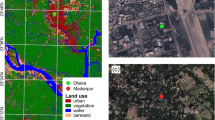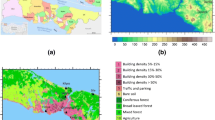Abstract
Ulaanbaatar, the capital city of Mongolia, with a population of 1.1 million is located at an altitude of about 1350 m and in a valley. This study is the first to document the characteristics of the urban heat island (UHI) in Ulaanbaatar. Data from two meteorological stations, an urban site and a rural site, for the 31-year period 1980–2010 are used for UHI analysis. The average UHI intensity is 1.6°C. The UHI intensity exhibits a large seasonal dependence, being strongest in winter (3.3°C) and weakest in summer (0.3°C). The average daily maximum UHI intensity is 4.3°C. The strongest daily maximum UHI intensity occurs in winter with an average intensity of 6.4°C, and the weakest one occurs in summer with an average intensity of 2.5°C. The occurrence frequency of the daily maximum UHI intensity in the nighttime is 5.6 times that in the daytime. A multiple linear regression analysis is undertaken to examine the relative importance of meteorological parameters (previous-day maximum UHI intensity, wind speed, cloudiness, and relative humidity) that affect the daily maximum UHI intensity. The half of the variance (49.8%) is explained by the multiple linear regression model. The previous-day maximum UHI intensity is the most important parameter and is positively correlated with the daily maximum UHI intensity. Cloudiness is the second most important parameter and is negatively correlated with the daily maximum UHI intensity. When the data are classified into daytime/nighttime and season, the relative importance of the meteorological parameters changes. The most important parameter in spring and summer is cloudiness, while in autumn and winter it is the previous-day maximum UHI intensity.
Similar content being viewed by others
References
Amarsaikhan, D., M. Ganzorig, H. H. Blotevogel, B. Nergui, and R. Gantuya, 2009: Integrated method to extract information from high and very high resolution RS images for urban planning. J. Geogr. Reg. Plann., 2, 258–267.
Boo, K.-O., and S.-N. Oh, 2000: Characteristics of spatial and temporal distribution of air temperature in Seoul, 1999. J. Korean Meteor. Soc., 36, 499–506 (in Korean with English abstract).
Fan, H., and D. J. Sailor, 2005: Modeling the impacts of anthropogenic heating on the urban climate of Philadelphia: a comparison of implementations in two PBL schemes. Atmos. Environ., 39, 73–84.
Figuerola, P. I., and N. A. Mazzeo, 1998: Urban-rural temperature differences in Buenos Aires. Int. J. Climatol., 18, 1709–1723.
Giovannini, L., D. Zardi, and M. De Franceschi, 2011: Analysis of the urban thermal fingerprint of the city of Trento in the Alps. J. Appl. Meteor. Climatol., 50, 1145–1162.
Goldreich, Y., 1984: Urban topoclimatology. Prog. Phys. Geog., 8, 336–364.
Google Inc., 2011: Google Earth. http://maps.google.com. Accessed 30 September 2011.
Hinkel, K. M., F. E. Nelson, A. E. Klene, and J. H. Bell, 2003: The urban heat island in winter at Barrow, Alaska. Int. J. Climatol., 23, 1889–1905.
Jarvis, A., H. I. Reuter, A. Nelson, and E. Guevara, 2008: Hole-filled SRTM for the globe version 4. http://srtm.csi.cgiar.org. Accessed 8 September 2011.
Jauregui, E, L. Godinez, and F. Cruz, 1992: Aspects of heat-island development in Guadalajara, Mexico. Atmos. Environ., 26B, 391–396.
Kim, Y.-H., and J.-J. Baik, 2002: Maximum urban heat island intensity in Seoul. J. Appl. Meteorol., 41, 651–659.
_____, and ______, 2004: Daily maximum urban heat island intensity in large cities of Korea. Theor. Appl. Climatol., 79, 151–164.
Klysik, K., and K. Fortuniak, 1999: Temporal and spatial characteristics of the urban heat island of Lodz, Poland. Atmos. Environ., 33, 3885–3895.
Kottek, M., J. Grieser, C. Beck, B. Rudolf, and F. Rubel, 2006: World map of the Köppen-Geiger climate classification updated. Meteor. Z., 15, 259–263.
Lee, S.-H., and J.-J. Baik, 2010: Statistical and dynamical characteristics of the urban heat island intensity in Seoul. Theor. Appl. Climatol., 100, 227–237.
Liu, W., C. Ji, J. Zhong, X. Jiang, and Z. Zheng, 2007: Temporal characteristics of the Beijing urban heat island. Theor. Appl. Climatol., 87, 213–221.
Magee, N., J. Curtis, and G. Wendler, 1999: The urban heat island effect at Fairbanks, Alaska. Theor. Appl. Climatol., 64, 39–47.
Montávez, J. P., A. Rodríguez, and J. I. Jiménez, 2000: A study of the urban heat island of Granada. Int. J. Climatol., 20, 899–911.
Morris C. J. G., I. Simmonds, and N. Plummer, 2001: Quantification of the influences of wind and cloud on the nocturnal urban heat island of a large city. J. Appl. Meteorol., 40, 169–182.
Oke, T. R., 1982: The energetic basis of the urban heat island. Quart. J. Roy. Meteor. Soc., 108, 1–24.
_____, 1987: Boundary Layer Climates. 2nd ed. Routledge, 435 pp.
Ryu, Y.-H., and J.-J. Baik, 2012: Quantitative analysis of factors contributing to urban heat island intensity. J. Appl. Meteor. Climatol., 51, 842–854.
Taha, H., 1997: Urban climates and heat islands: albedo, evapotranspiration, and anthropogenic heat. Energ. Buildings, 25, 99–103.
Unger, J., 1996: Heat island intensity with different meteorological conditions in a medium-sized town: Szeged, Hungary. Theor. Appl. Climatol., 54, 147–151.
Unwin, D. J., 1980: The synoptic climatology of Birmingham’s urban heat island, 1965–74. Weather, 35, 43–50.
Author information
Authors and Affiliations
Corresponding author
Rights and permissions
About this article
Cite this article
Ganbat, G., Han, JY., Ryu, YH. et al. Characteristics of the urban heat island in a high-altitude metropolitan city, Ulaanbaatar, Mongolia. Asia-Pacific J Atmos Sci 49, 535–541 (2013). https://doi.org/10.1007/s13143-013-0047-5
Received:
Revised:
Accepted:
Published:
Issue Date:
DOI: https://doi.org/10.1007/s13143-013-0047-5




